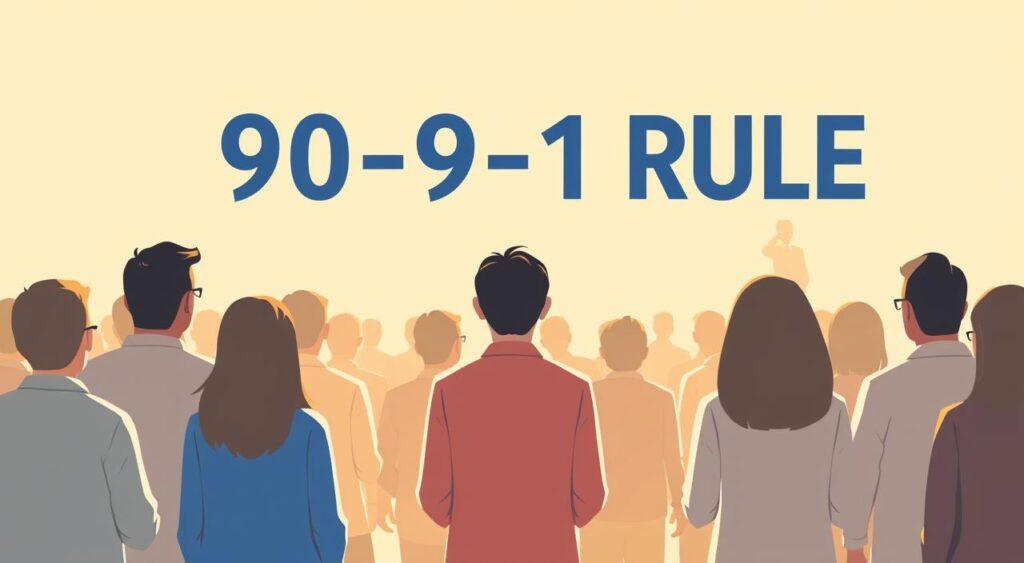Have you ever wondered why most online spaces feel dominated by a handful of voices? The 90-9-1 rule mental model reveals a hidden pattern shaping digital interactions: 90% of users quietly consume content, 9% engage occasionally, and just 1% create nearly everything.
This imbalance isn’t random—it’s a blueprint for understanding how online communities function.
Researchers like Jakob Nielsen and Will Hill first identified this participation inequality decades ago. Their work shows platforms from Reddit to YouTube follow this pattern.
Think about your last social media scroll—how often did you comment versus simply read? You’re not alone. Most people prefer observing, leaving a small group to steer conversations and set trends.
For businesses, this model changes everything. Building thriving communities requires designing for silent observers and active contributors. Platforms succeed when they nurture that 1% while making the 90% feel welcome. As highlighted in marketing strategies, ignoring this balance risks creating ghost towns or echo chambers.
Why does this matter now? Because every like, share, or post you make today feeds into this invisible framework. Recognizing it helps you build better spaces—online and offline—where everyone’s role matters.
Key Takeaways
- Online communities typically have 90% passive observers, 9% occasional contributors, and 1% active creators
- This participation gap influences platform culture and content direction
- Successful community-building requires strategies for all user types
- The The 90-9-1 rule mental model pattern appears in social media, forums, and knowledge-sharing platforms
- Early research by Nielsen and Hill remains relevant in modern digital spaces
What Is the 90-9-1 Rule Mental Model in Practice?

The 90-9-1 rule mental model is seen in today’s big platforms. On YouTube, a few creators make most of the content. But most people just watch or comment sometimes.
TikTok’s For You page is filled with daily posts from many creators. Yet, most users just scroll through.
On LinkedIn, 1% of users make most of the content. 9% react or share sometimes. And 90% just read without commenting.
This pattern is also seen in Reddit threads, Facebook groups, and Slack channels. It’s not just for entertainment or public forums.
In customer feedback, corporate systems, or educational platforms, the 90-9-1 rule applies. It shows who gets heard and how information flows. Knowing this helps leaders meet community needs and boost engagement.
Understanding the Origins of Participation Inequality

Long before hashtags and viral trends, digital communities showed a curious pattern of participation inequality. Researchers digging through early internet archives found that while most voices stayed silent, often referred to as users lurkers, a few dominated conversations.
This imbalance wasn’t accidental—it was baked into how users contribute and interact online, highlighting the inherent inequality in digital spaces.
Historical Insights and Early Research
Will Hill’s 1990s work at Bell Communications Research revealed striking data. His team analyzed forums like Usenet newsgroups and CompuServe boards. They discovered 3% of active posters created 25% of all messages. Even in corporate discussion systems, this pattern held true.
Early platforms displayed surprising consistency. A study of 2 million Usenet posts showed:
| Platform | Low-Activity Users | High-Activity Contributors |
|---|---|---|
| Usenet Newsgroups | 580,000 single-post users | 19,000 frequent posters |
| CompuServe Boards | 72% read-only members | 4% created 60% of content |
| Internal Company Forums | 89% never posted | 2% drove 80% of discussions |
Key Studies from Jakob Nielsen and Others
Jakob Nielsen’s later work gave this phenomenon its memorable name. His studies across wikis and social media confirmed Hill’s findings. Active contributors didn’t just post more—they shaped entire communities’ cultures.
Why does this matter today? Because these patterns explain why some online spaces thrive while others stagnate. Recognizing participation inequality helps us design better platforms where both listeners and leaders feel valued.
Exploring The 90-9-1 Rule Mental Model

Imagine logging into your favorite online forum. Thousands might view discussions daily, but only a few names appear repeatedly.
This invisible structure shapes how ideas spread and communities evolve. Let’s break down the three key roles that form this ecosystem of participation inequality.
The silent majority—90% of members—act as observers. They absorb content like sponges but rarely comment or post. These users lurkers form the foundation of any platform’s audience, driving view counts without leaving digital footprints. This example illustrates the inequality in contributions across different user roles.
| User Role | Activity Level | Platform Influence |
|---|---|---|
| Silent Observers | Read/watch only | Indirect through views |
| Occasional Voices | Comment sometimes | Amplify key messages |
| Core Creators | Post daily | Set community agenda |
Nine percent emerge when specific topics spark their interest. These occasional contributors might share expert advice on cooking forums or react to breaking news in niche groups. Their participation often depends on timing and personal relevance.
The remaining 1% operate like digital conductors. They post within minutes of events, answer questions rapidly, and generate most original content. This intense activity lets them steer conversations and establish community norms through sheer consistency.
Why does this imbalance persist? Human behavior naturally leans toward observation in unfamiliar environments. Platforms magnify this tendency through design choices—like highlighting popular posts or making commenting feel intimidating.
Recognizing these patterns helps users navigate spaces more intentionally and creators build more inclusive environments.
Impact on Online Communities and Content Creation

Digital platforms often feel like crowded rooms where only a few voices get heard. This participation inequality creates ripple effects across online communities, influencing everything from product reviews to political debates.
Let’s explore how this silent majority/loud minority dynamic transforms our digital experiences on social networks at various times of the day.
When Feedback Becomes a Megaphone
Businesses often mistake vocal minorities for customer consensus. Imagine relying on restaurant reviews where only furious diners or ecstatic fans bother to write. This inequality in feedback systems distorts reality, creating skewed perceptions of quality.
Search engines face similar challenges. Their algorithms prioritize content shared by active contributors, potentially elevating niche opinions over widely-held perspectives. This explains why some search results feel disconnected from mainstream needs.
The Cultural Architects of Digital Platforms
Active users don’t just post frequently—they design the cultural blueprint of online communities. Their preferences determine trending topics, acceptable humor styles, and even conflict resolution norms. New members either adapt to these unwritten rules or remain silent observers.
Political discussions on social media showcase this impact vividly. Platforms become echo chambers where moderate voices drown in waves of polarized commentary. The silent 90%’s views remain invisible, creating false narratives about public opinion.
Recognizing these patterns helps us navigate digital spaces more wisely. Should that scathing product review dictate your purchase?
Does a trending hashtag reflect genuine movement or coordinated posting? Understanding participation inequality turns us into smarter consumers of online content.
The Lurking Effect: Silent Majorities in Digital Interaction

Every online community thrives on an unseen force—the silent watchers who shape success through their attention. Despite making up 90% of users, these observers leave no comments or likes.
Yet their presence fuels platforms: Technorati found only 5% of 1.1 billion internet users blogged in 2006, while Twitter’s 2019 data revealed 75% never tweeted.
Lurker Behavior Across Social Networks
Platforms show striking differences in passive engagement. Reddit’s 2017 study showed over 90% of accounts never post. Instagram sees lurkers saving posts privately 3x more often than sharing publicly. Why? Some lack time to craft responses—others fear judgment or prefer learning quietly.
These silent participants validate creators through views and watch time. A cooking channel’s 10,000 views with 20 comments signals healthy lurking, not disinterest. Savvy community builders recognize this, using systems thinking to design spaces where observers feel included without pressure to perform.
Next time you scroll without engaging, remember—you’re part of a vital ecosystem. Your attention shapes trends as much as any viral post. How might platforms better honor this quiet majority?
Empowering the Core Contributors: The 1% Advantage

Behind every thriving online platform lies a hidden engine—a small group of devoted contributors who shape experiences for millions.
These superusers don’t just participate in user activity—they build foundations that keep communities alive, highlighting the inequality in participation among frequent contributors.
Significance of Active Superusers
Wikipedia’s ecosystem reveals this power imbalance in stark numbers. Though 32 million Americans visit monthly, just 68,000 active users make edits. The most dedicated 1,000 contributors handle two-thirds of all changes—equivalent to 15 full-time employees working nonstop.
| Platform | Total Users | Top Contributors | Contribution Impact |
|---|---|---|---|
| Wikipedia | 32M monthly visitors | 1,000 editors | 66% of all edits |
| Amazon Reviews | 300M+ customers | Top 100 reviewers | 167,113 reviews |
These participants often treat contributions like second jobs. One Amazon reviewer wrote 12,423 evaluations—enough to fill 15 novels. Their consistency builds trust, turning casual browsers into loyal users.
Platforms thrive when they remove friction for these power contributors. Simplified editing tools on Wikipedia or review ranking systems on Amazon help superusers work efficiently. As research on participation inequality shows, nurturing this 1% creates ripple effects across entire networks.
How can we better support these vital people? By recognizing their outsized impact and designing systems that amplify—not hinder—their passion. After all, a single dedicated contributor often influences more users than a thousand silent observers.
Encouraging Sustainable Contributions from Superusers
Platforms get a lot from superusers, but burnout is a big problem. A study in the Journal of Internet Medical Research showed that contributors often feel stressed. This stress can lead to exhaustion and even make them leave the community.
To keep superusers happy, platforms need more than just leaderboards. They should be open about how their work impacts others. They should also offer mental health support and let contributors take breaks.
Places like Stack Overflow have tried mentorship programs. They pair experienced users with newcomers. This way, everyone can share the workload. Simple ideas, like “scheduled break” badges, help keep people involved without making them always visible.
Strategies for Boosting Engagement Among the 9%

What if small design tweaks could turn casual browsers into active contributors? Platforms thrive when they meet users where they are—not where designers wish they’d be.
The occasional 9% hold untapped potential, needing intuitive systems that respect their time and energy. This effect can transform a website into a service that engages a million users, leveraging the side effect of increased participation, also known as user engagement.
Creating User-Friendly Interaction Systems
Lowering barriers works wonders. Netflix transformed movie ratings into single clicks—no essays required. Editing existing content feels less daunting than starting from scratch. Pre-built templates or simple polls let users share insights without creative burnout.
Smart platforms bake participation into daily habits. Amazon’s recommendation engine turns purchases into passive data contributions. Fitness apps auto-generate progress reports from logged workouts. These side effects of normal use create value without extra effort.
90-9-1 Rule Mental Model: Rewarding Occasional Contributors
Recognition beats rewards. A cooking forum highlighting “most helpful tweaks” to recipes motivates more participants. Gamification works when subtle—think LinkedIn’s profile-completion meter. But over-rewarding can distort genuine engagement, as recent research on contributor mental health shows.
Progress-tracking tools help occasional voices see their impact. A language app showing “You’ve helped 50 learners” encourages continued sharing. The key? Design ways to participate that feel natural, not forced. How might your favorite platform better serve its quiet majority?
Reducing Psychological Barriers to Participation
People often stay quiet not because they’re not interested. They might fear criticism, feel like their opinions don’t matter, or aren’t sure what’s okay. In some places, newcomers hesitate because they think their ideas aren’t good enough.
In other areas, the atmosphere can seem too exclusive or critical. This makes it hard for them to join in.
To overcome these fears, we need to make it safe and easy to participate. We can do this by setting clear rules, allowing comments to be anonymous, or using simple reactions like emojis. These steps help newcomers feel more at ease.
Using the right words also helps. Instead of asking people to post their thoughts, we can say “Share one idea” or “Start with a quick reaction.” When things feel simple and friendly, more people will be willing to share.
Conclusion
The 90-9-1 rule mental model doesn’t just explain how online communities work—it reshapes how we approach engagement, leadership, and influence in digital spaces. Whether you’re designing a platform, moderating a forum, or simply browsing content, this mental model reveals invisible dynamics shaping every interaction.
From the silent 90% to the vital 1%, each role serves a purpose. Recognizing these contributions—seen and unseen—helps us create smarter systems, more inclusive communities, and better conversations.
Next time you scroll without posting, or notice the same names popping up in every thread, ask yourself: what role am I playing today—and how could this space make room for more voices?


